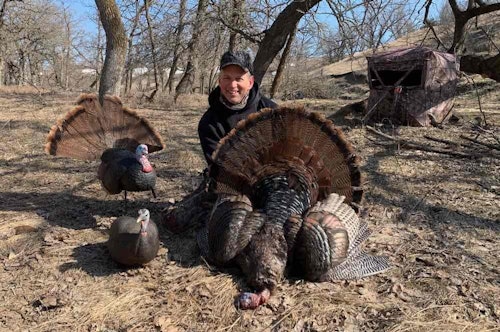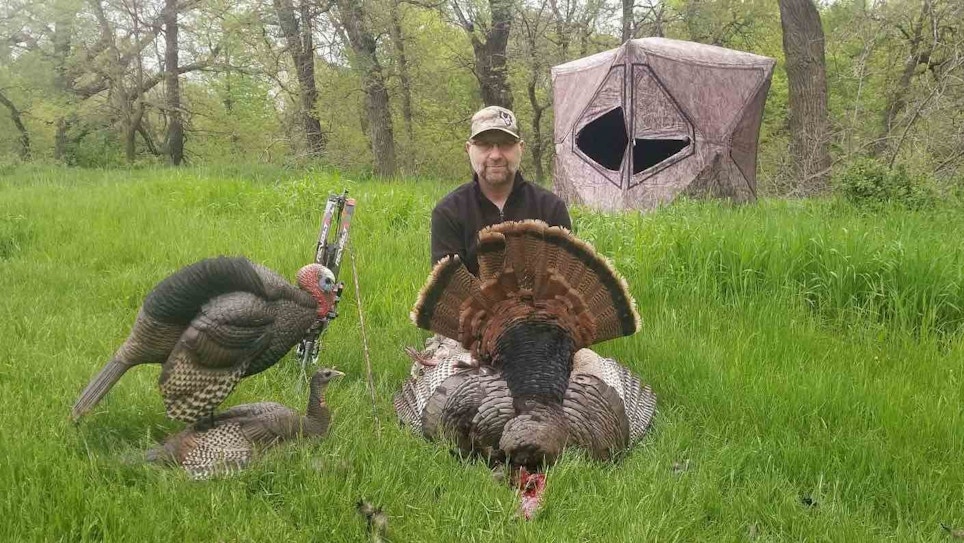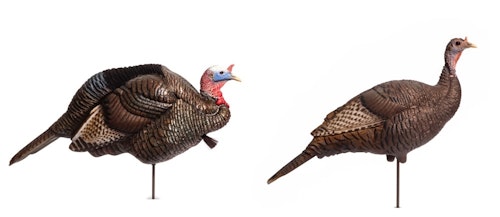Shooting a turkey with a shotgun is great fun — I’ve done it from Minnesota to Florida and many states in between. I’m not a fan of doing everything possible when it comes to tweaking guns, chokes, optics and ammo to kill them at long range. In my opinion, turkey hunting is a challenge of how close, not how far. I’ve dropped gobblers at 40 yards with my Remington 870 (standard full choke; no optics), but I almost always wait for a chance to pull the trigger on a bird that’s inside 30 yards. It’s simply more exciting to kill ‘em at closer range.
If you want to maximize the excitement and challenge of turkey hunting this spring, then set aside time to pursue birds with archery gear — it’s the epitome of “closer range.” While I prefer specialized arrows and broadheads designed for head/neck shots on turkeys — at distances up to about 12 yards — it’s not mandatory. In fact, I know I’m in the minority when choosing this gear.
Fact: You can use the same bow, arrows and broadheads for turkeys that you already own for whitetails or other big game. That said, I do recommend that you purchase the following three products to help close the deal on a wild turkey.
1: Pop-Up Ground Blind
It’s possible to arrow a wild turkey from a natural ground blind, or even spot-and-stalk, but the chance of a turkey seeing you draw your bow is high — even more so than with a whitetail. I think the reason is that a whitetail relies on its nose first and its eyes and ears second to detect danger. A turkey doesn’t rely on its nose to avoid predators — it’s sight first, and sound second.
I provide this background because one product you should really have in your bowhunting toolbox for turkeys is a pop-up ground blind. The good news is you don’t have to spend an arm and a leg; so many companies make decent pop-up ground blinds that the prices have come down significantly in the last decade. I suggest you look at the Ameristep Brickhouse, Barronett Ace 250, Primal Outdoors Vision 270, Primos Double Bull Roughneck or Rhino-500.

Tip for using a pop-up blind for turkeys: While whitetails are quick to notice a ground blind’s open-window “black hole,” turkeys don’t see it as danger. With whitetails, it’s best to use the shoot-through mesh to avoid spooking them; you can drop the mesh and use open windows for turkeys. Dress in black clothing (photo above) to disappear in the blind’s dark interior.
2: Top-Notch Turkey Decoy
Regardless of whether you sit in a natural ground blind or a pop-up, I think it’s mandatory to use a lifelike turkey decoy. If you can afford only one, then buy a hen. However, you’ll often have better success by placing a jake with a hen.
I’ve killed lots of turkeys when gun hunting with the use of inexpensive collapsible foam turkey fakes, but to hold a turkey’s attention at close range, you need better ones. My absolute favorites are Dave Smith Decoys (DSD). Most often I’m setting out a DSD 3/4 Strut Jake (standard head color option) and a DSD Upright Hen. I like to place the hen on the ground in a bedded/mating posture (i.e. don’t use the stake) with a jake about a foot behind her. Note: DSD offers a Mating Hen, and it works great, but I like the versatility of the Upright Hen — using her with or without the stake. Another great choice is the Avian-X HDR Jake matched with the Avian-X HDR Hen.
Decoying distance tip: For head/neck shots, I place my jake and hen decoy combo at 5 to 10 yards. I draw as a tom is approaching, and like to shoot at the precise moment when the bird stops. Typically, a tom will stop just before it gets to the jake decoy, I suspect it’s a dominance display, and the tom expects the jake to flee. When it doesn’t, then the tom often pounces on the jake decoy. This is super exciting to witness at close range, but it also makes executing a killing shot quite difficult. Learn from my experience — shoot before the rodeo begins.
3: Box Call
I’m not one of those turkey “experts” who say you must carry a box call, pot/slate call, various mouth calls, etc., and try them all, letting the turkeys tell you which one they want that day. If you want to load up your turkey vest with every call design under the sun, go for it. But when it comes to calls, I keep it simple.
I often carry one mouth call and one box call, but if I’m being honest, I could get by with only the box call 99 percent of the time. A mouth call is great for making turkey sounds when you want to keep your hands on your bow. That said, once a tom sees my decoy setup, I almost always stop calling and let my decoys finish pulling the bird into bow range.
Of course, there are dozens and dozens of box call options. And what sounds good to you is a matter of personal preference. FYI: Each spring I begin my South Dakota turkey season in a river-bottom loaded with birds (often 100 roosted within sight of my pop-up blind), and I can promise you that wild turkeys make a wide variety of sounds — some are pitch-perfect, others sound like the worst turkey caller on the planet!
For me at least, I can make the subtle/soft yelps and purrs best with a box call that requires chalk to function properly. That said, I love the reliability of a box call that doesn’t require chalk.
A couple options I can recommend: I like the Primos Waterboard box call (doesn’t require chalk), and also the Rocky Mountain Hunting Calls Turkey Strutter box (uses chalk). The vast majority of my calling is loud; I don’t see birds and I’m trying to get their attention. Both of these calls do an outstanding job cutting through the wind.
Box call tip: It’s annoying if a box call makes noise while you’re hiking to your destination. To keep it quiet, pin the paddle to the sounding chamber with a heavy-duty rubber band.








